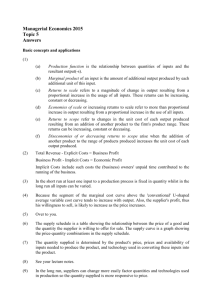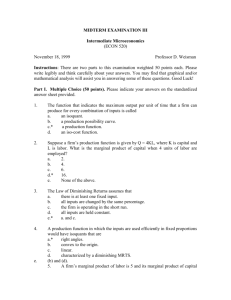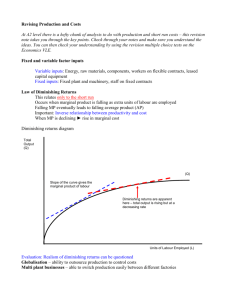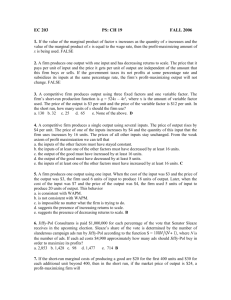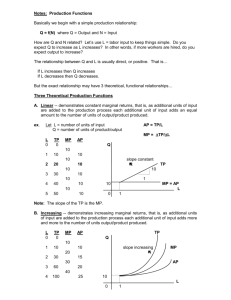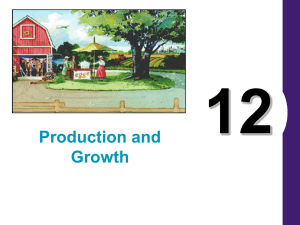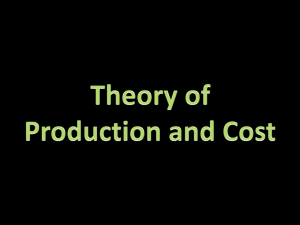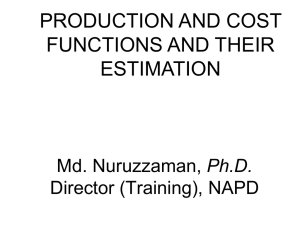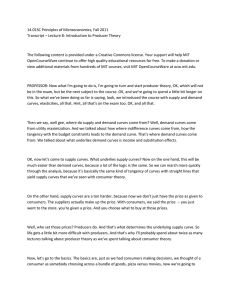Economics - Production Function and Laws of Production * 1 Short
advertisement
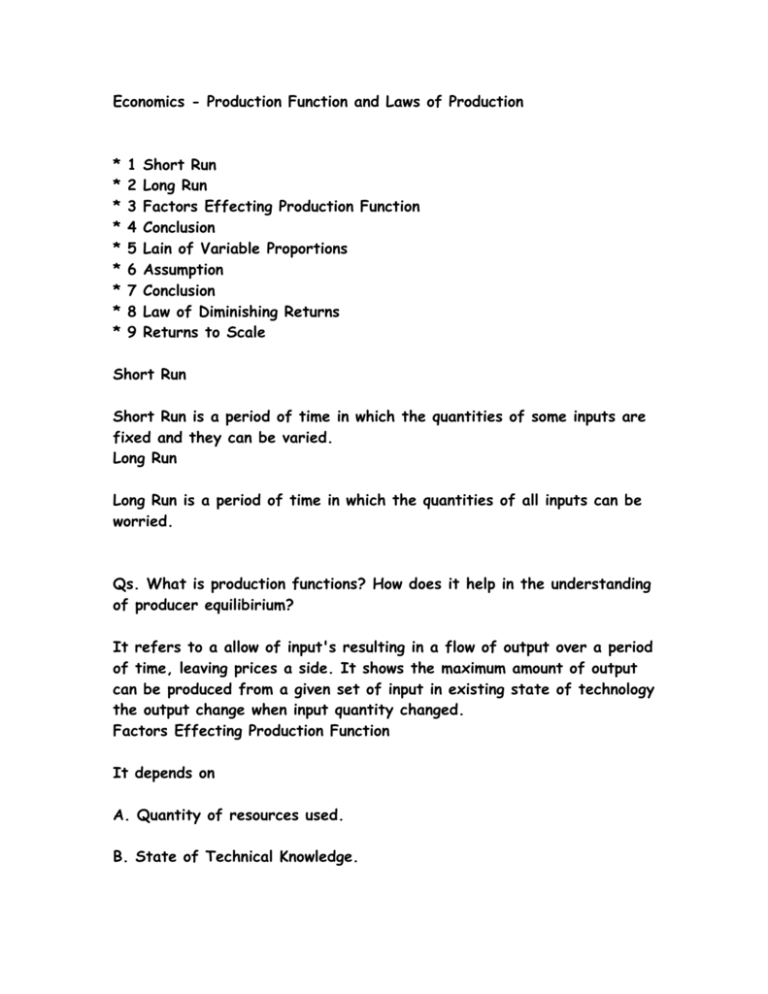
Economics - Production Function and Laws of Production * * * * * * * * * 1 2 3 4 5 6 7 8 9 Short Run Long Run Factors Effecting Production Function Conclusion Lain of Variable Proportions Assumption Conclusion Law of Diminishing Returns Returns to Scale Short Run Short Run is a period of time in which the quantities of some inputs are fixed and they can be varied. Long Run Long Run is a period of time in which the quantities of all inputs can be worried. Qs. What is production functions? How does it help in the understanding of producer equilibirium? It refers to a allow of input's resulting in a flow of output over a period of time, leaving prices a side. It shows the maximum amount of output can be produced from a given set of input in existing state of technology the output change when input quantity changed. Factors Effecting Production Function It depends on A. Quantity of resources used. B. State of Technical Knowledge. C. Possible Process. D. Size of the Firms. E. Nature of Firm's organisation. F. Relative prices of the Factors of Production. As these factors change production function also change Production plant size can be change in Long run but not in Short run. X = f (a,b,c,d,.....) Where X = output per unit time a,b,c,d = are input used for making goods. In order to understand production function we have few things in mind. i. There is a technical relationship the input or output of product without considering price factor. ii. Combination of factor of production gives output. Output increases as the factor of production organised in a good number. iii. Preductively depends on the nature of technology used, like labour, intensive firm depend on their quantity of labour. A change in technology will can shift to another production function. According to Cubb Dougler production functin Q = KLaC Where Q ----> Quantity Manufactured L ----> Labour Employed K and a ----> lue constants and (a < 1) C ----> Capital Used. Conclusion The study of the theory of production is the study of production function itself. It helps to understand the law of proportin where keeping on a factor of production we increase the other factors. Qs. State and explain the law of variable proportion Illustrate diagramitically OR Discuss the law of variable proportion and explain the conditions of its applicasity. Lain of Variable Proportions If we know that the outputs depends on the quantity and quantity of the factors of production. So in order to increase output we must have to change some factor production, keeping other factor constant. The law of variable proportion studies the effect of output of varriation in factor proportion. As the proportion of one factor is combination of one factor increased after a point find the marginal and then the average product of that factor will diminish. OR An Increase in some inputs relative to other comparatively fixed inputs will cause outputs to increase but after a point the extra output relating from the some addition of input will become less and less. Assumption i. Technology remains constant other wise marginal and the average curver vise instead diminishing. ii. Only one point is variage other being be constant. iii. It assume a short run between in long run and all inputs can be changed. Stage 1 As we see that from 1 to 4 workers work on 40 acres gives the higher output and Marginal product increase. Stage 2 We see when increase the number of worker from 5 to 8 the total product increase but marginal product remain same. Stage 3 After increasing more work we see still total product increased but marginal product decrease. Conclusion So if analyse if we increase more worker we got increase in TP and MP but as we increase so much worker TP may be increase and MP decline and it is fact so many worker spoil the good or made the quantity difference. Qs. Write notes on Laws of Diminishing Returns? Law of Diminishing Returns Diminishing Returns occur in all when labour input increases. There is a change in output as we increase any one variable factor keeping offers constant. Returns to Scale A change in scale occurs when there is an equal % change in the use of all firms input. If we increase 1 worker and one machine for knitting sweater from 4 worker and 1 machine. we double scale of production. There are three types of possible cases. 1. Constant returns to scale. 2. Increasing returns to scale. 3. Decreasing returns to scale. 1. Constant Returns to Scale. Constant returns to scale occur when the % increase in firms output is equal to the % increase in its inputs. It means when a firm doubles all its input its output exactly double. Example (Put yourself) 2. Increasing Returns to Scale OR Economics of Scale. Increasing return to scales occur when the % increases in output exceeds the % increase in output.It means when a firm double its input the output will be move then double. Economics of scale occur in production process. Where increased output exises a firm to use a more productive technology. Example (by yourself) 3. Decreasing Returns To Scale OR Diseconomics of Scale. When the % increase in output is less than % increase in inputs then we say Decreasing Return to Scale occur. It means when a firm double its input and output increases 50% it means diseconomics of scale are present. Example (By yourself) Example Suppose a knitting firm with one worker and 1 knitting machine gives 4 sweater. * If he doubles the firm's input to 2 knitting machine and 2 workers and they gives 15 sweaters a day. we said increasing return to scale or Economics of scale. * If the increase 4 knitting machine and 4 workers and then gives 25 sweaters a day, it means decreasing to return to scale of diseconomics of scale.


